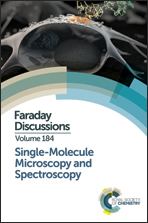Polarization effects in lattice–STED microscopy
Abstract
Massive parallelization of STED-like nanoscopies is now achievable using well-designed optical lattices for state depletion. Yet, only the lattice intensity distribution was considered for the description of the super-resolved point spread function. This holds for fast-rotating fluorescent emitters. Here, we study the effects of electric field topography in lattice–STED microscopy. The dependence of the super-resolved point spread function on the number of dipoles and their orientation is investigated. Single fluorescent nano-diamonds are imaged using different optical lattice configurations and the measured resolutions are compared to theoretical simulations.
- This article is part of the themed collection: Single-Molecule Microscopy and Spectroscopy

 Please wait while we load your content...
Please wait while we load your content...